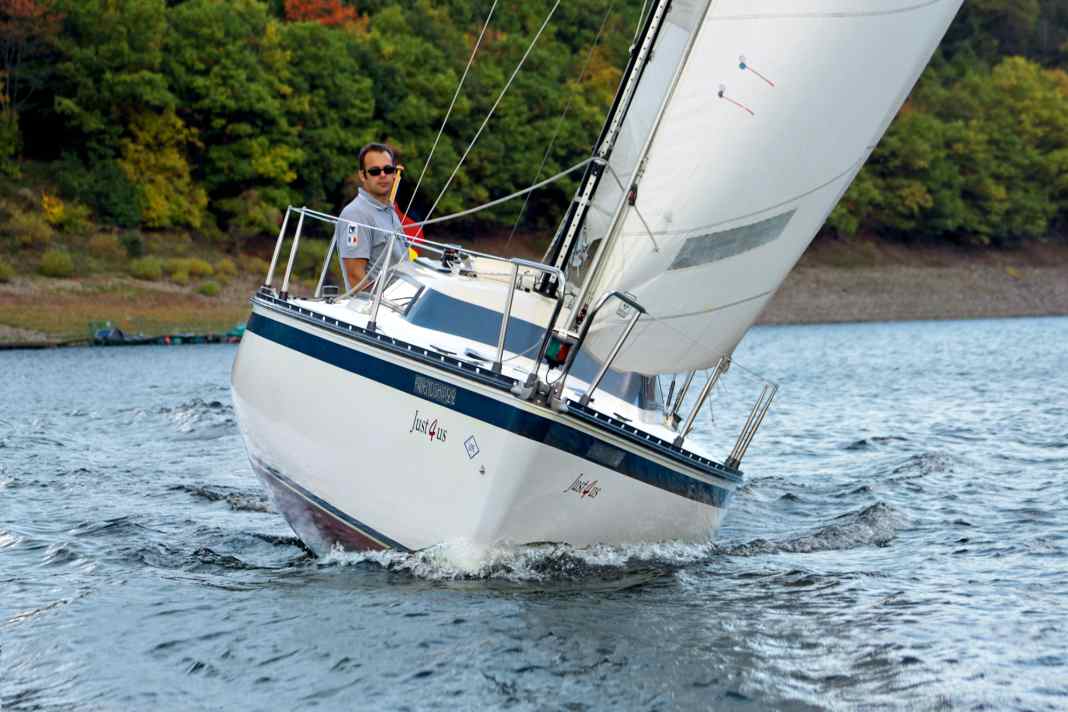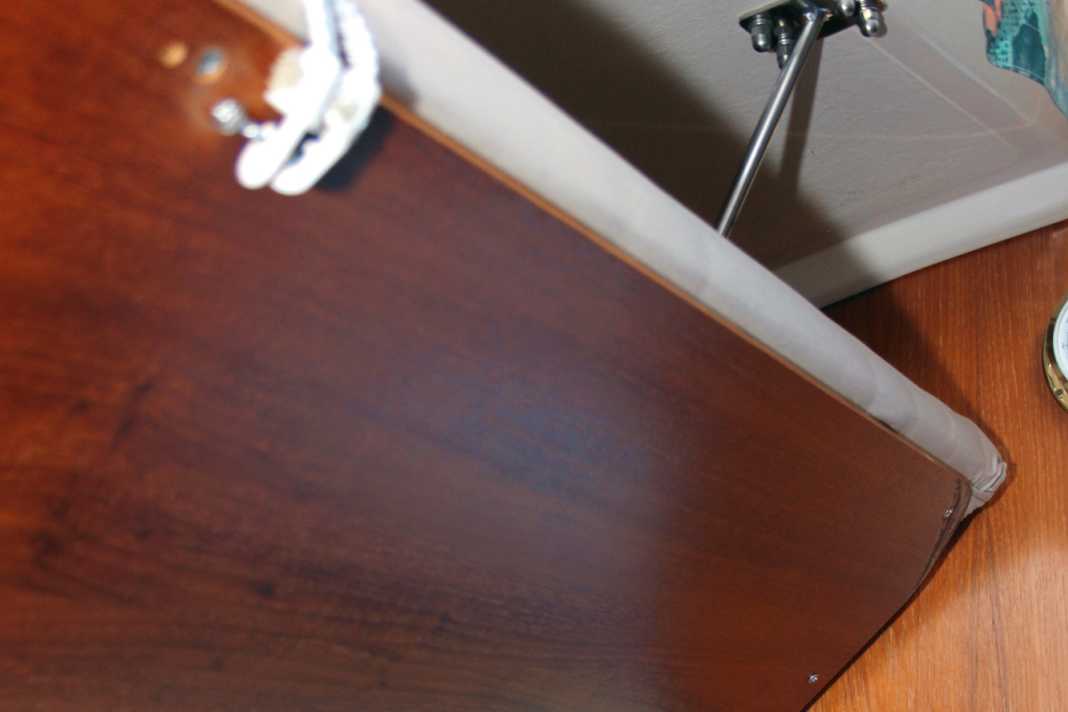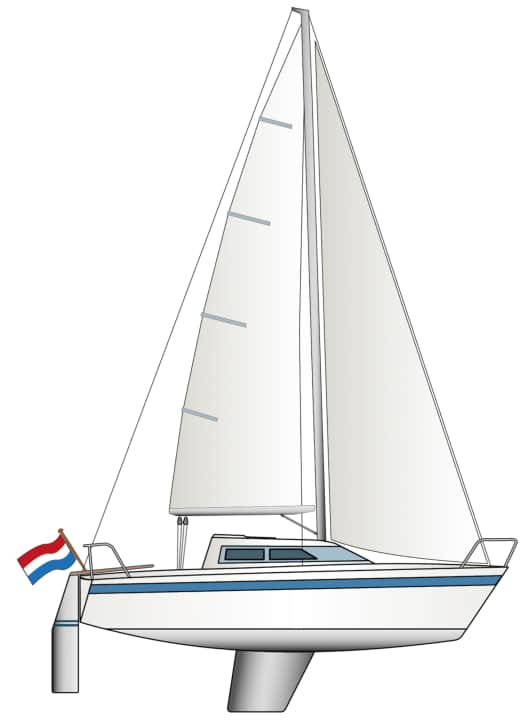Friendship 22: Former top small cruiser proves itself in a used boat test
Alexander Worms
· 12.09.2024






There are designs that outlast all time and all fashions - in automotive engineering, for example, the Jaguar E-Type or the Boeing 747 in aviation. They captivate with the aura of their forms, eternally beautiful and attractive - and admired by many people. And they work, they fulfil their purpose with style.
Of course, boatbuilding has also produced such icons. The Ur-Varianta was one. Or the Optima 101, later the Dehler 34, which became IOR world champion. And the early Maxis from Pelle Petterson anyway, if only because of the huge numbers produced. Noble boats like the Swan 48 from Sparkman & Stephens and everyday boats like the Folkeboot. And the Friendship 22.
Also interesting:
The Friendship 22, a design classic? Isn't that too much honour for such a little ship? The suspicion is obvious, because what can be particularly good on 22 feet? And indeed, she is almost a little shy on the jetty, not flamboyant, loud, rather matter-of-fact, well-proportioned, but without show effects. The magic only becomes apparent on second glance. Every dimension, every angle and every detail fits. The deflection of the foresheet to the winches, for example, is so cleverly solved that there are no overruns.
The spacing of the dents in the cockpit - just right for medium-sized people when heeling. As are the berth lengths of two metres forward and 1.95 metres in the saloon. It goes without saying that the seat height in the saloon is also suitable. You could even stand under a sprayhood in the companionway.
Well, other small cruisers can do that too. However, even today, almost 40 years after its market launch, the Friendship 22 does not look out of date: simply a classic. The ratio of hull to superstructure is right, the stern remains surprisingly wide by the standards of the time, and the large side window strip in combination with the decorative strip ensures modernity without being "hip". And the whole thing is decorated with very solid workmanship and fine sailing characteristics.
A test winner
In short, the design was pioneering at the time, and it still works four decades later. Our colleagues at YACHT probably recognised this at the time and awarded a "very good" test rating to a new boat for the first time ever. As a result, as was reported at the time, the shipyard in Balk, Friesland, received 50 orders within a few days.
The fact is that the boat smithy did well over the next few years. Around 50 people built Friendships up to 38 feet in length. On a website of the Dutch owners' club, a certain Klaas from Balk reported that he had worked at Jachtwerf Meijer for 23 years, producing the interior of a 22-footer every week alone, made of boatbuilding plywood with thick veneers and also with wood-panelled lockers on the inside. The high structural quality of the boats can also be explained by such long-serving employees, which by all accounts is not an isolated case at Meijer.
As the owners emphasised a good atmosphere and ambitious skilled workers, employees and workers identified strongly with the company and ultimately with the product. The consistently high level of production resulted in the creation of a robust, modern classic that remains rigid even with age.
However, when the Meijer family retired and sold the company, the slow decline of the brand began. New, larger models, new locations, overly expensive production with consistently high quality meant that one owner after another failed the Friendship project. Until 2006, there were repeated attempts to revitalise the brand - without success. The last attempt was made by a company in Lemmer, Friesland, which held the brand rights and offered spare parts. However, the factory gates there also closed recently. The supply of spare parts is therefore unfortunately uncertain at present.
Several thousand Friendships remained on the market in various lengths and configuration variants. For example, the 22, which was also available with a dog bunk on the starboard side instead of the locker and with a lockable main bulkhead and thus a separate foredeck, whereby the open version is certainly the wiser choice because of the better feeling of space.
The draughts were also variable. 1.10 or 1.35 metres with the same ballast - no problem before CE; a ballast centreboard was also possible. This version was included directly in the design and was not an afterthought.
A boat that is fun
The test boat from 1984, construction number 2031, is equipped with a 1.35 metre deep keel. This contributes to stability late on, but is effective against drift.
Unfortunately, it is not possible to make precise statements about the turning angle, as no regular measurements were possible on the Rursee test area; a slightly gusty wind and the associated constant turning in the high double-digit degree range caused the tester to capitulate.
When a gust comes in, the following happens: The Friendship takes over in a sporty manner without appearing nervous, she lies down on the rubbing strake, typically IOR in her own wave system, thus lengthening the waterline and setting off. This is great fun, the ship is fully in its groove.
Unfortunately, this fun doesn't last during the test, because either the wind is gone again straight away, or the helmsman has to either luff up or fall off in dimensions unfamiliar to those unfamiliar with the area. How much fun the "Friendship" must be if you can let it run for a while in constant wind!
Don't get the wrong idea: She is extremely agile at the helm, attention is required and she is by no means a straight-ahead vehicle. Manoeuvrability in small areas is therefore no problem at all, on the contrary. Thanks to the long lever, the attached rudder is capable of throwing the boat round the corners when required, for example when shooting upwind or when a gust needs to be steered out.
The trims are varied, but the fittings are a little dated. If you don't like the clumsy operation, you can replace them to suit your taste and budget. For example, the sails.
During the test, it was possible to tickle a speed of five and a half knots through the water in around ten knots of wind from the worn-out cloths; with a new wardrobe, more would certainly be possible. But even as it was, the Friendship was easy and a real pleasure to sail. Sitting on the bevelled coaming, two sheets within reach, the headsheet led to windward over the leeward winch, the boom in hand, the little ship could be steered dinghy-like into every gust.
At night you sleep cosy and dry in a cabin with a cooker and not on the cockpit floor under an incontinent tarpaulin. And the whole thing also fits on the trailer behind a powerful mid-range diesel. In addition, capsizing is not an issue thanks to the keel, and the ship also offers safety with a closed cockpit and deflected halyards. In a way, the Friendship combines the best of two worlds - small boat and yacht.
Not everything is perfect
As good as the overall package is, you should pay attention to a few points when buying. For once, osmosis is only a rare occurrence on these boats, obviously good gelcoat was used. Nevertheless, it is always worth taking a look at any blisters immediately after uncraning or slipping.
But more importantly, what is the situation around the keel and is the deck still stiff? On the test boat, there were clear hairline cracks at the aft end of the keel inside the ship, a typical symptom of running aground damage. Although the chocks are large, the strongback is only a few centimetres high. This is problematic when it comes to transferring forces during overrun. It is therefore advisable to remove the topcoat and gelcoat when the opportunity arises and to check for white cracks in the laminate. An additional reinforcement at the end of the keel can also be laminated into the bilge.
In addition, the test boat had stainless steel nuts screwed onto steel bolts without a lock, which can lead to corrosion problems - this should also be changed. The same applies to the sanitary silicone used as a sealant; flexible sealant has no place between the keel and hull. At best, the keel seam can be subsequently sealed with an MS polymer.
The balsa sandwich deck is sensitive to moisture ingress. The surrounding area must be carefully checked for strength, especially in the case of retrofitted penetrations. If the deck is soft, a costly repair is required.
The Friendship was originally also available with a Volvo Penta petrol engine and Saildrive. If this still works, make sure that the fuel system is leak-proof, otherwise there is a risk of explosion. If a Saildrive is installed, retrofitting a diesel can be a good step. However, the new engine is likely to be about as expensive as the entire used boat - an investment that is reluctant to be made on the second-hand market.
Still very good
If you are looking for a trailerable small cruiser for less than 10,000 euros, you should take a look at the various Friendships on the market. The differences can be seen in the state of maintenance. The test boat was always under a tarpaulin, so the gelcoat is correspondingly good; even the blue trim strip could be polished up. Problems on the keel or deck can be rectified on your own with a little skill in handling resin and hardener.
The overall picture is characterised by a solid construction, good sailing characteristics and a relatively large amount of space below deck. A well-rounded package, also thanks to the shipyard's reputation, trailerability and low costs for winter storage. Alternatives include the Dehlya 22 , which costs about the same, and the Shark 24, which delights regatta sailors with an active single class. However, the Friendship is the more timeless design, which should continue to be attractive and thus retain its value with appropriate care. As classics go.
Girlfriend with quirks






The friendships are very well done throughout. Nevertheless, some structurally relevant points require a thorough assessment
The Friendship 22 in detail

Technical data of the Friendship 22
- Designer: Jac de Ridder
- Built: 1978 to 2005
- Torso length: 6,60 m
- Width: 2,50 m
- Draught/alternative: 0,70-1,45/1,10, 1,35 m
- Weight: 1,3 t
- Ballast/proportion: 490 kg/38 %
Hull and deck construction
Hull solid polyester spray laminate and hand-laid roving mats. Deck balsa sandwich and inner shell
Price and shipyard
- Base price ex shipyard 1979 (adjusted for purchasing power): 27.000 €
- Used boat price: 5000 to 20,000 €
Status 09/2024
YACHT review of the Friendship 22
Trailerable entry-level boat for small families. Solidly built, sails well. In short, the FS 22 is a good choice for anyone starting out in sailing
Design and concept
- + Good berth dimensions
- - Low initial stability
Sailing performance and trim
- + Agile sailing even in light winds
- + Many trimming devices
Living and finishing quality
- + sliding pantry
- - Cable between inner shell and deck without conduits
Equipment and technology
- + Hinge at the base of the mast
- - Anchor locker cover difficult to open
This article first appeared in YACHT 2 4/2017 and has been updated for this online version.

